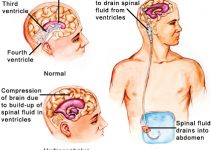The brain is best described as the component of your body that holds the reins to all its other major and minor systems, even while you are asleep!
When you have surgery it is always wise to learn about the possible side effects of brain surgery.
In order for you or any other person to successfully carry out an action, the real governor of your body (the brain) draws information from all the sensory organs, processes it and finally enables you to complete the particular action. This process is more complex than it seems.
It involves intercommunication between many subsystems.
The delicate human brain covered with three protective layers (meninges) consisting of three sections- the forebrain (cerebrum and diencephalon), midbrain and hindbrain (includes the cerebellum and brain stem).

Table of Contents
Brain Surgery
Although the working of the human brain is complex, the system is quite delicate and has a consistency similar to that of jelly.
Even with the protection offered by bone, strong tissues and fluids, it remains susceptible to infections, trauma, and abnormal growths.
Sometimes, surgery on the brain forms an important treatment option to save the lives of patients.
There are a variety of reasons for brain surgery, also known as a craniotomy or neurosurgery. It is a surgical procedure performed on the affected structures in or around the brain.
Alterations in the flow of blood within the brain (hemorrhages), changes in the cerebrospinal fluid (infections) and brain tissue (cancer, swelling) are conditions under which surgeons need to consider neurosurgery.
The various types of brain cancer that require craniotomy are as follows: gliomas, lymphomas, pituitary tumor, medulloblastoma, schwannoma, secondary tumor, chordomas, etc.
Head injuries such as concussions, scalp wounds, contusions, hemorrhages or fractures of the skull due to accidents also require brain surgery. Strokes can lead to potentially fatal brain injury and the same is true when the blood flow increases, which can lead to the rupture of small vessels in the brain.
A Brief Description of a Craniotomy

A craniotomy is defined as a surgical operation that involves opening the skull for access to the brain and treatment of the defect or infection.
The scalp needs to be cut through to repair and ligate the ruptured blood vessels and to remove any abnormal growth or blood clot. Sometimes the patient is kept awake during the procedure.
Side Effects of Brain Surgery
Like any other invasive procedure, brain surgery is closely associated with many side effects.
However, the likelihood of side effects increases significantly when it comes to the surgery of the brain as it is the master of all body controls.
The intensity and duration of the side effects vary in accordance with the reason for the operation and the area of brain on which the operation was carried out.
In some uncommon cases, people have to re-learn some or all basic skills such as reading and writing.
The malignant and benign tumors of the brain can cause substantial tissue damage. Thorough removal of all affected tissue is important to prevent the tumor from spreading further or from recurring.
Although this does save the patient’s life, removing tissue leads to complications.

Infections– Infection constitutes an unwanted effect related to brain surgery. If bacteria gain access to the brain during the procedure, chances of brain infection are high.
For example, infection due to Staphylococcus Aureus can lead to meningeal inflammation.
As a small hole is made in the skull, the patient stands a fair chance of acquiring a skull infection. A proper antibiotic regime is started immediately to prevent such after-effects.
Bleeding– There is a possibility of post-operative intracranial bleeding in cases in which surgical eradication of a malignant or benign tumor has been carried out.
This bleeding is known as hemorrhage and it causes an increase in pressure. This spike in pressure either within or on the brain as well as the surrounding structures has the potential to reach alarmingly high levels, leading to either unconsciousness or death.
Some symptoms that suggest intracerebral bleeding include nausea, sudden headache, vomiting and loss of sensation leading to numbness. Weakness is another important symptom. One must call for a doctor’s help immediately on noticing these symptoms.
Seizure– Seizures are caused by the unusual electrical activity within the brain. Post neurosurgery, seizures are quite common and may occur either immediately, after a few months or even many years after the day of operation.
If the seizure does occur soon after the completion of the surgery, it is regarded as a “provoked” seizure. Some seizures are classified as ‘unprovoked’ if they continue to occur for a long time after the surgery. Patients belonging to the latter category are diagnosed as epileptic.
Seizures occur because, after the removal of damaged or infected tissue, the brain makes new but different connections with the nerves.
Such abnormal connections lead to unprovoked seizures which range in frequency. The good news is that many such seizures are treatable via effective anticonvulsant drugs.
Stroke– A stroke is defined as an emergency medical situation in which the blood flow in the brain experiences a sudden interruption. Blocked vessels may be a cause of stroke, especially after brain tumor removal surgery.

In such a condition, brain cells of that particular region die due to the lack of oxygen. Irreversible brain damage can occur in those affected areas that may be involved with functions such as speech, movement or vision. Such patients experience weakness or even paralysis.
Additional side effects of brain surgery
Coma– Coma is another side effect either during or post-surgery. In this state, the affected patient is unconscious and fails to move or respond.
Brain damage– Removal of damaged tissue in the brain sometimes leads to the removal of some unaffected tissue as well.
The possibility of damage to the normal tissues also exists. Brain damage can be either temporary or permanent.
Symptoms gradually fade out in temporary cases, but the ones with permanent damage of tissue require rehabilitation. Such damage can also alter personality.
Brain swelling– Accumulation of the cerebrospinal fluid (CSF) or swelling of the brain can lead to increased intracranial pressure.
Such elevated pressure leads to a feeling of lethargy, vomiting or headache. In such cases, certain changes in the behavioral patterns may be noticed. Steroids are recommended to bring the pressure down.
In cases of elevated intracranial pressure, another intervention is required when CSF is increasing.
The treated area may experience certain skin reactions too. The ear and operated scalp may turn itchy or experience a change in color (similar to sunburn).
Protection from the sun and exposure to air are important for the treated area to heal properly.




